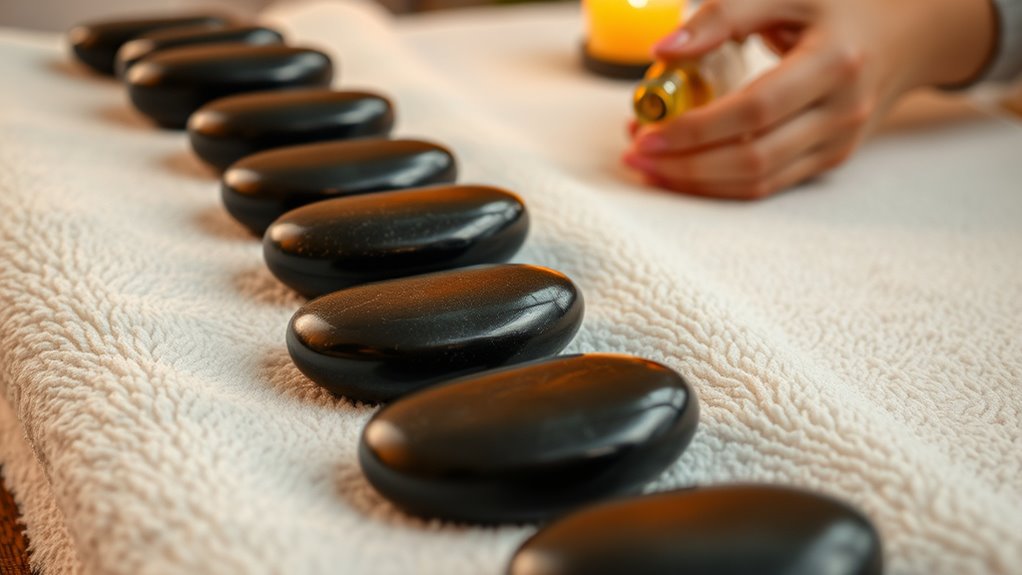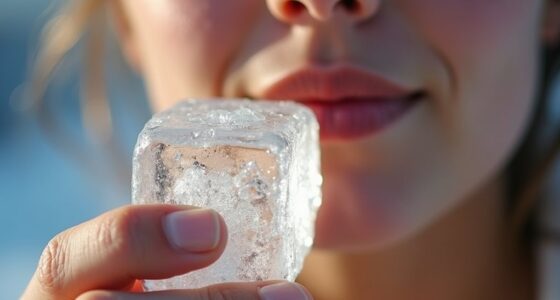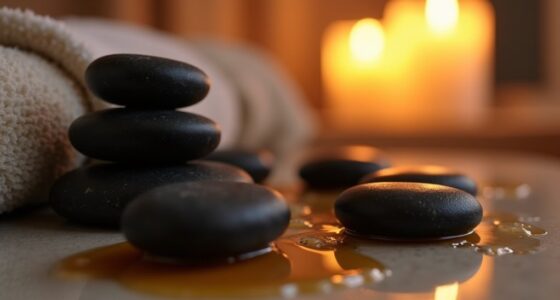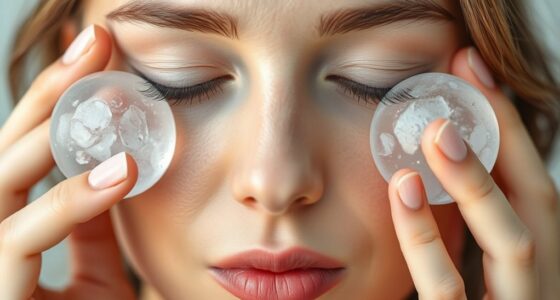To practice hot stone therapy at home, gather smooth basalt stones, heat them in warm water or a stone heater, and test their temperature before applying. Use gentle, oil-lubricated strokes on areas like your back or shoulders, placing stones strategically for deep relaxation. Focus on breathing and comfort, avoiding any discomfort. This ancient technique enhances relaxation and circulation—continue exploring how to elevate your self-care routine with simple, effective tools and techniques.
Key Takeaways
- Use smooth basalt stones heated in warm water or a stone heater, ensuring they are comfortably warm before application.
- Apply a light carrier oil, like coconut or jojoba, to skin for smooth stone gliding and added comfort.
- Place heated stones on key muscle areas such as shoulders, back, or thighs, and use gentle, slow massage movements.
- Test stone temperature regularly to prevent burns or discomfort, adjusting heat as needed during treatment.
- Focus on areas of tension to promote relaxation, improved circulation, and stress reduction through self-massage techniques.

Hot stone therapy is a relaxing massage technique that uses heated stones to melt away tension and soothe muscles. While it might seem like a modern spa indulgence, its roots trace back to ancient healing practices. Cultures like the Chinese, Egyptians, and Native Americans used heated stones for therapeutic purposes long before today’s spa treatments. These civilizations believed that the stones could balance energy, improve circulation, and promote overall wellness. Today, this ancient wisdom influences how you can bring hot stone therapy into your home, blending history with contemporary self-care.
In a modern spa, hot stone therapy is often seen as a luxurious way to unwind, but you don’t need to visit a high-end facility to experience its benefits. You can incorporate similar techniques into your routine using at-home tools. The key is to select the right stones—usually smooth, flat, and made of basalt, which retains heat well. When heating the stones, you want them warm but not scalding, so always test their temperature before application. A simple method is to place the stones in a bowl of warm water, or use a specialized stone heater designed for at-home use. This allows you to bring the ancient healing tradition into your daily life, making self-care accessible and convenient.
To enhance your at-home hot stone massage, you’ll want a few essential tools: the heated stones, a carrier oil like coconut or jojoba to prevent discomfort, and a comfortable space where you can relax fully. As you begin, apply a small amount of oil to your skin to help the stones glide smoothly, avoiding any pulling or discomfort. Gently place the warm stones on key areas like your back, shoulders, or thighs, allowing the heat to penetrate deep into your muscles. Use slow, deliberate movements to massage with the stones, mimicking the techniques used in professional treatments. This practice not only relaxes your muscles but can also improve circulation, reduce stress, and promote mental clarity.
Frequently Asked Questions
Can Hot Stone Therapy Be Safely Performed on Children?
Hot stone therapy isn’t recommended for children because pediatric safety is a priority. You should avoid using hot stones on kids, as their skin is more delicate and sensitive. Instead, focus on child-friendly techniques like gentle massage or calming touches. Always consult a healthcare professional before trying any new therapy on children to guarantee safety and appropriateness. Prioritize their well-being and follow expert guidance for a safe, positive experience.
How Often Should I Repeat Hot Stone Treatments at Home?
Frequency guidelines favor flexibility—you should start with treatments once a week, then adjust based on your body’s response. Safe practice tips include monitoring skin reactions, avoiding overly hot stones, and respecting your comfort level. Listen to your body’s signals, and if soreness or discomfort occurs, reduce the frequency or seek professional advice. Consistency nurtures relaxation, but safety always comes first in your at-home hot stone therapy routine.
Are There Any Specific Oils Recommended for At-Home Hot Stone Therapy?
You should use essential oils like lavender, eucalyptus, or peppermint for at-home hot stone therapy. These oils can be added to massage blends or carrier oils such as coconut or jojoba. Always dilute essential oils properly to prevent skin irritation, and choose high-quality, pure oils for the best results. Testing a small patch first helps ensure you don’t have an allergic reaction.
What Are the Signs of Skin Irritation From Hot Stones?
If your skin shows signs of irritation from hot stones, you’ll notice skin redness and itching. These are common indicators that the heat may be too intense or your skin is sensitive. To prevent further irritation, stop the treatment immediately, cool the area with a damp cloth, and avoid applying any oils or products that might worsen the reaction. Always test the temperature first to keep your skin safe.
Can Hot Stone Therapy Help With Chronic Pain Conditions?
Hot stone therapy can be a gentle tide that eases your chronic pain. It offers benefits for arthritis by reducing joint stiffness and alleviating muscle tension. When combined with muscle relaxation techniques, the warmth penetrates deep into muscles, soothing soreness and promoting circulation. While it’s not a cure-all, regularly using hot stones at home can help manage pain levels and improve overall comfort, making your daily life more manageable.
Conclusion
With these at-home hot stone techniques, you hold the key to turning your space into a soothing oasis. Imagine each stone as a gentle wave of warmth washing over your stress, melting away tension like ice under the summer sun. Embrace the calming dance of heat and touch, transforming your routine into a tranquil retreat. With a little practice, you’ll create a sanctuary where relaxation flows as effortlessly as a peaceful river.









